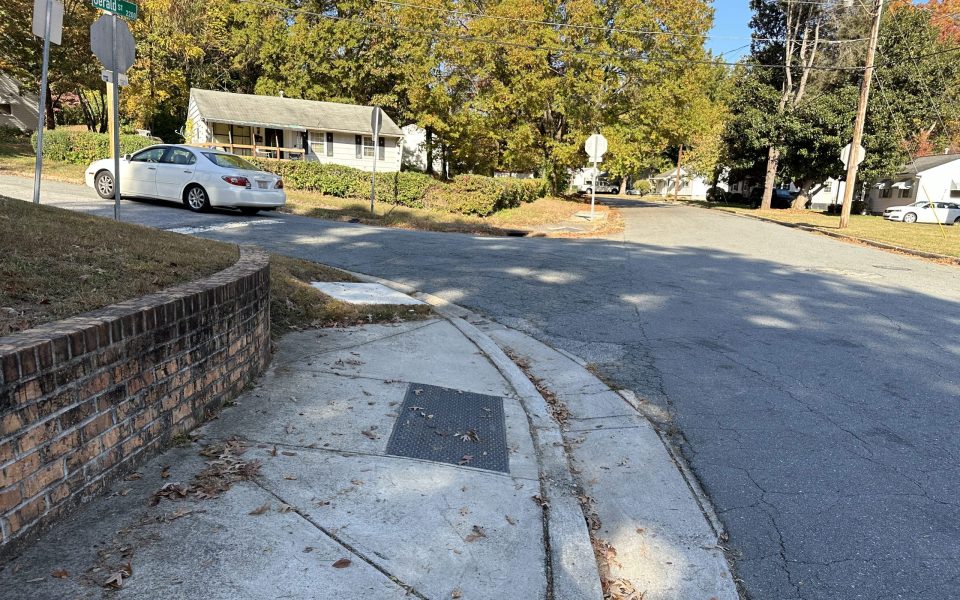Featured photo: The sidewalk at the corner of Gerald Street and 12th Street in Winston-Salem. (photo by Gale Melcher)
Once you participate in a walk audit, a walk down the street will never be the same.
That sentiment rings true to more than a dozen volunteers who walked Winston-Salem’s Reynoldstown and Slater Park neighborhoods on Saturday morning. Both are located in the East Ward, represented by Councilmember Annette Scippio. Scippio requested audits for these neighborhoods back in June.
In some parts of these neighborhoods, houses sit close together with limited parking space. The slim roads leave little room for street parking, so cars are often parked over the curb and onto the sidewalks in order to leave room for drivers. Many of the sidewalks are narrow, uneven and overgrown with weeds. Some sidewalks are less shaded than others. Crosswalks are a rare sight.
“We have quite a few [neighborhoods] in the East Ward,” Scippio told volunteers on Saturday, “that have been historically Black, and they haven’t gotten a lot of attention over the years.”
Redlining and lack of investment harmed many neighborhoods on the east side of the city.
“I was fortunate to grow up in a time when our neighborhoods were vibrant: where everybody knew everyone, where most of the people were homeowners, where they looked out for each other and cared about each other,” she said.
But now, with so many people renting houses, “neighbors aren’t neighbors like they used to be,” Scippio said.

Carol Hoover, the vice chair of the city’s Bicycle/Pedestrian/Active Mobility advisory committee, originally presented the walk-audit idea to Scippio.
To Hoover, walking is the easiest form of exercise anyone can do.
“Slap on a pair of tennis shoes, walk out your door and go.”
But people want to walk where it’s safe, Hoover said.
A healthier community is created by making “safe streets for people to be active on,” Hoover said. But the city doesn’t have enough staff to send to every neighborhood to find problem areas.
That’s where city residents stepped up.
Volunteers took to the streets to conduct a block-by-block analysis of the neighborhoods, noting aspects of walkability such as the width and condition of sidewalk panels, overgrown vegetation obstructing paths, streetlights, road signs and crosswalks — or lack thereof.
Volunteer Rita Brown walked up and down Addison Avenue and Gerald Street. As Brown made notes, the lack of crosswalks and cracked sidewalks in the Slater Park thoroughfares posed a problem, especially for those using walkers or a wheelchairs. The lighting was on the opposite side of the sidewalk. Cars flew through the neighborhood as there wasn’t a posted speed limit. Stop signs leaned.
Tactile ground indicators can help people with vision impairments know that they’ve reached the end of the sidewalk. Some of the intersections along Brown’s route were missing indicators.

Brown documented the location of the problem areas so city staff can solve the issues later on.
What’s the worst thing Brown saw on her walk? Uncovered storm drains that were “so big that even an adult could fall into them,” she said. Many of the drains didn’t have metal grates and were only protected by slabs of concrete.
“I feel like I’ve made a valuable contribution to this neighborhood,” Brown said after turning in her findings from the walk.
“I didn’t realize that the walkability in that neighborhood was that poor,” she said.

‘Winston-Salem is not unique’
In an interview with Triad City Beat, Hoover explained that the city’s walkability issues are part of a nationwide phenomenon.
“Winston-Salem is not unique,” Hoover said, noting that departments of transportation in municipalities across the country are also short staffed.
“We have miles and miles of sidewalks that have been installed since the 1930s, 1940s, maybe even before then, and we keep installing sidewalks,” she said. That makes it hard for city staff to keep tabs on all of them.
With aging infrastructure in cities across the US, the citizen-driven walk audit has become very important, Hoover said.
“Once you do this, you become more aware of the surroundings,” Hoover noted.
One of the sidewalks on Triad City Beat’s route had an entire panel missing.
Navigating around something like that can be challenging, and the walk audit makes people “realize how difficult it is,” Hoover said.
Hoover said that the city could fix some issues volunteers found on their walks fairly easily “within the next couple of months.”
Special machines can level the sidewalks, the overgrown vegetation can be cleared, signs can be added and crosswalks can be painted.

“What can’t be done so quickly is that missing sidewalk panel or a missing sidewalk. Those are very expensive and take a lot longer,” Hoover said.
According to the city’s website, their engineering division uses bond funds, when appropriated, to rehabilitate the city’s sidewalks.
Some compromises will have to be made. For example, installing a sidewalk on a highly-traveled road would take priority over installing a second sidewalk on a street that sees less traffic.
“We really do have to think about what the city can and can’t do,” Hoover said.
Volunteer Kenell Caesar audited Rich Avenue in Reynoldstown, and said that changes definitely need to be made.
“We have to come together as a community to push forward on that movement,” Caesar told Triad City Beat.
Caesar said that the most concerning thing he saw was the state of the sidewalks — littered with lumps and cracks.
“Me and my neighbors, we value our elders,” Caesar said, adding that many older people live in his neighborhood.
They want to be able to “get out and walk without tripping, without falling.”
A fall can be a “major detriment to their health,” Caesar added.
If the city does another walk audit, Caesar said he will “definitely” participate.
“We have pride in our community,” Caesar said, but added that the “optics” are not showing it.
Caesar said that the walk audit “makes you pay attention,” adding, “Imagine what the neighbors are feeling like…when this is right in front of them, in front of their house, and they can’t really do much — if anything — about it.”
All CityBeat reporting content is made possible by a grant from the NC Local News Lab Fund, available to republish for free by any news outlet who cares to use it. Learn More ↗
Republish this storyJoin the First Amendment Society, a membership that goes directly to funding TCB‘s newsroom.
We believe that reporting can save the world.
The TCB First Amendment Society recognizes the vital role of a free, unfettered press with a bundling of local experiences designed to build community, and unique engagements with our newsroom that will help you understand, and shape, local journalism’s critical role in uplifting the people in our cities.
All revenue goes directly into the newsroom as reporters’ salaries and freelance commissions.


Leave a Reply